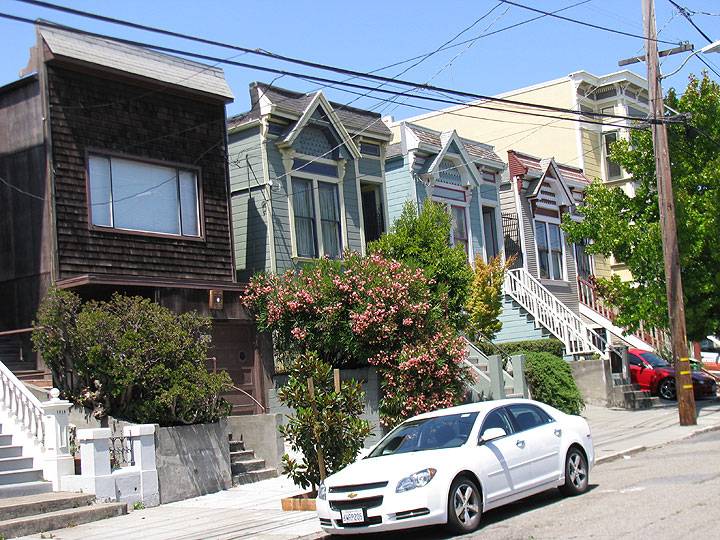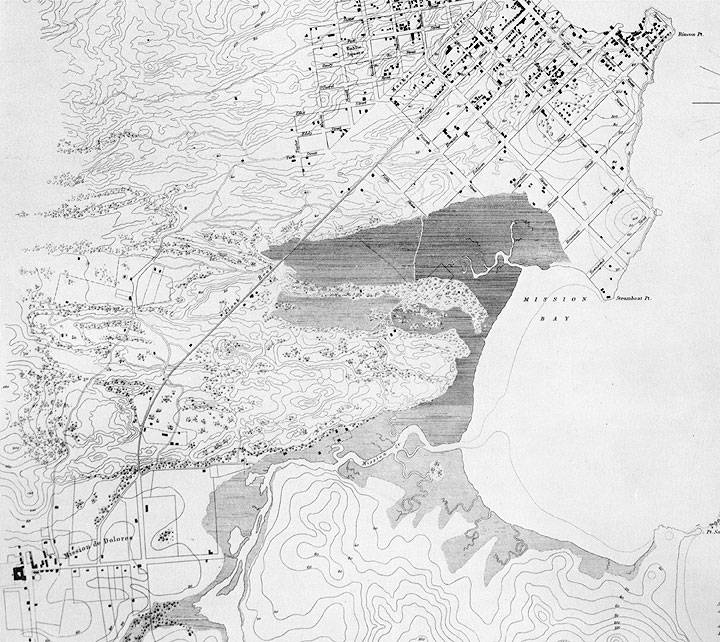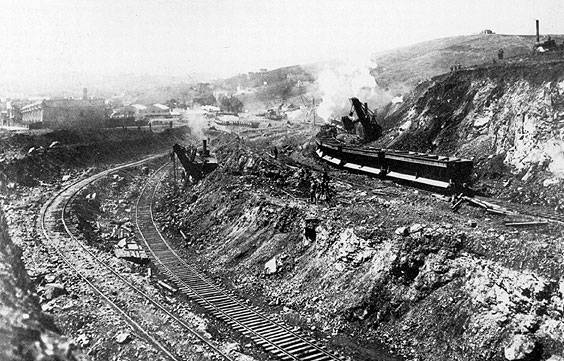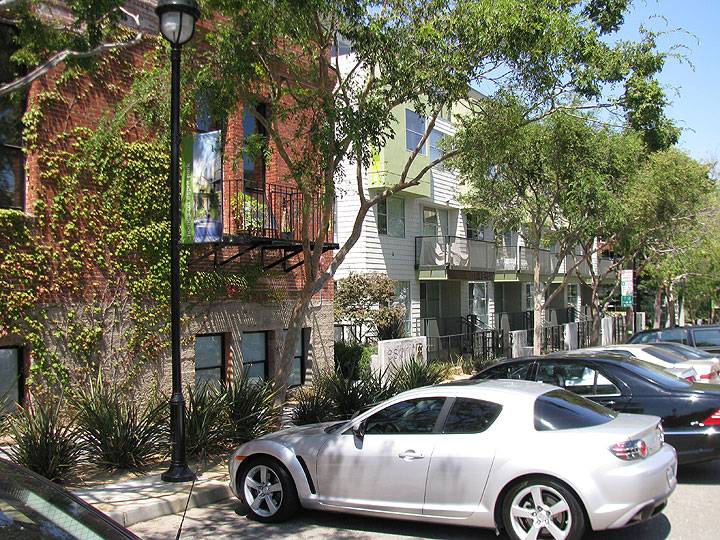The Story of Dogpatch
Historical Essay
by Christopher VerPlanck
Note: This is a slightly revised version of a document prepared in support of the application by the Dogpatch neighbors to receive historical district status.
Dogpatch is an approximately nine-block enclave of industrial workers’ housing located east of Potrero Hill, in San Francisco’s Central Waterfront district. The neighborhood is comprised of almost one-hundred flats and cottages, as well as several commercial, industrial and civic buildings, most of which were erected between 1870 and 1930.
The neighborhood is significant under National Register Criterion A (Patterns of History) and Criterion C (Design/Construction). The neighborhood is significant on the local city level under Criterion A, within the category of Industry, as the oldest and most intact concentration of industrial workers’ housing in San Francisco. No other district of San Francisco or California was industrialized to the degree of Potrero Point during the last quarter of the 19th Century.
The shipyards and other maritime-related industries of Potrero Point required a steady supply of inexpensive immigrant labor in an area that was geographically cut off from the rest of the city. Local developers and landholders, including Santa Fe Land Improvement Company, filled this need by constructing rows of inexpensive cottages and selling individual parcels to laborers and their families, allowing the neighborhood to develop as an informal company town.
One of the clusters of Pelton cottages, this on Tennessee Street, in Dogpatch.
Photo: Chris Carlsson, 2012
Dogpatch is also significant on the local level under Criterion A, under the category of Exploration/Settlement, as the first housing developed in the Potrero District. Initially developed in the early 1870s, Dogpatch became the nucleus of the Potrero District that would evolve after the 1906. Finally, Dogpatch is significant under Criterion C as a moderately intact district of mostly Victorian and Edwardian-era era workers’ dwellings constructed between 1870 and 1910. The district has several clusters and pairs of identical dwellings, including a group of thirteen identical Eastlake-style cottages based on the plans of San Francisco architect John Cotter Pelton, Jr. While the significance of Union Iron Works/Bethlehem Steel is national, the significance of Dogpatch is local.
The period of significance for the survey area dates from 1867, the opening of Long Bridge and the beginning of construction in the neighborhood, to the end of World War II.
Background: Spanish and Mexican Periods
What is now Dogpatch has a long record of human history dating from the local Native American residents of pre-European contact days to the present day. From 1776 until after the end of Spanish rule in 1821, all of Potrero Hill was used for grazing by at Mission Dolores to rear livestock for the Mission and the military garrison at the Presidio of San Francisco. In 1833 the Mexican government secularized the missions of Alta California. Although partly intended to free the indigenous people of California from peonage, the concurrent patenting of vast ranchos by the Mexican government resulted in the division of Mission Dolores’ land amongst the powerful descendents of the original Spanish settlers.
All of what is now Potrero Hill, including Potrero Point, became part of a vast ranch known as Rancho Potrero de San Francisco, or simply Potrero Nuevo. Potrero Nuevo was granted to the sons of Francisco de Haro, the first alcalde of San Francisco and its boundaries were the same formidable natural features that have traditionally isolated the neighborhood from the rest of the city. Potrero Nuevo was ideal pasturage as it needed little fencing due to the presence of considerable natural boundaries, including Mission Creek to the north, San Francisco Bay to the east, Islais Creek to the south and the western escarpment of Potrero Hill to the west.[1]
Early American Period
In the years following the American conquest of California in 1846 the settlement of Yerba Buena (renamed San Francisco in 1847) was largely confined to a several-block area surrounding Portsmouth Square. Although the Gold Rush pushed settlement south of Market Street to Steamboat Point, access to Rancho de Potrero Nuevo was hindered by the shallow tidal flats of Mission Bay. Nonetheless, this geographic isolation did not stop squatters from attempting to settle the steep slopes of Potrero Point, a 100’-tall arm of Potrero Hill that projected eastward into the Bay. In 1849, John Townsend and Cornelius de Boom unsuccessfully attempted to establish a settlement on De Haro’s land at Potrero Point. This first attempt proved to be unsuccessful due to the remoteness of the site and conflicting land claims.[2]
February 1852—U.S. Coast Survey Map. At the time of this topographical survey, Potrero Point at the bottom of the map shows no buildings or economic development at all, making it well suited to the early explosives manufacturing that sited there soon after.
Powder Magazines
Within only five years of California’s admission to the Union in 1850, Potrero Point’s destiny as the most important zone of heavy industry on the West Coast had already been established. The 1852 Coast Survey map, the first official government map to depict Potrero Point, showed no buildings in the area now occupied by Dogpatch but within two years this situation changed dramatically. Increased population pressures, combined with a new city ordinance forbidding dangerous industries from being located anywhere near settled areas, compelled certain industries such as gunpowder manufacturers, to move beyond the city limits.[3] Due to its remoteness and abundant deep-water anchorages, Potrero Point was earmarked as the ideal location for relocating essential gunpowder manufacturing operations.[4] Such operations were needed in San Francisco to manufacture black gunpowder, which was used for hard rock mining in the Sierras and for city street grading.[5]
In 1854, E.I. du Pont de Nemours Company, one of the largest manufacturers of black gunpowder in the United States, constructed their first powder magazine on the West Coast on the south shore of Potrero Point near the corner of Maryland and Humboldt Streets, now the site of P.G. & E.’s Potrero Power Plant. Within a year, Hazard Powder Company constructed a second gunpowder manufacturing facility on 23rd Street, between Maryland and Louisiana Streets.[6]
The 1857 Coast Survey map shows that both operations were located on the south shore of Potrero Point, adjacent to wharves constructed for loading kegs onto ships. The gunpowder manufacturers remained at Potrero Point for about twenty-five years until the expanding city limits of San Francisco and encroaching residential districts on Irish Hill and Dutchman’s Flat compelled them to move on to more congenial locations. By 1881 both companies sold their plants to Claus Spreckels and moved to rural Contra Costa County.
Tubbs Cordage Company
Even before the completion of Long Bridge in 1867, maritime-related industries in search of large tracts of vacant land and deep water anchorage began joining the gunpowder manufacturers at Potrero Point. The earliest of these pioneer industries was a rope-making factory established by brothers Alfred and Hiram Tubbs called San Francisco Cordage Manufactory. After procuring the necessary machinery and hiring skilled laborers, the Tubbs brothers acquired a parcel of open land near the south shore of Potrero Point.[7] At this location the company started producing rope in 1857 and soon they were selling it to ship riggers and mining companies throughout the Western United States, Mexico, Peru, China and Japan.
The first structure on the site was a 35’ x 1,000’, one-story, wood-frame shed that extended in a southeasterly direction from the present-day intersection of Iowa and 22nd Streets to a wharf in the bay (see the image at the top of the page). The shed sheltered the rope walk, a 1000’ (later extended another 500’) platform used by skilled workmen to twist strands of yarn, made from hemp and abaca fibers, into ropes. Historic photographs and the 1886 Sanborn map indicate the presence of several imposing brick structures on the site, including a large brick structure marked “spinning jennies” and several smaller offices, warehouses and sheds. By 1889 the company was renamed Tubbs Cordage Company and it became one of the largest employers in the thriving residential community that had grown up just north of the plant in the l870s and 1880s. An article in the May 28, 1893 edition of the San Francisco Morning Call described Tubbs Cordage Company:
The works embrace several acres of land at the Potrero covered by immense fireproof buildings of brick and iron and which are all tile covered. In these structures the highest type of machinery that can be obtained for making cordage is in operation, showing the whole process of manufacturing every class and size of cables from the huge one, nine inches in circumference, to the one but a quarter of an inch in diameter, and including all of those products of manilla (sic) or sisal which enter so largely into the useful and mechanical requirements of the day.
The material finds its way from the Philippines or Yucatan by shiploads and comes to the works in its raw state, whence, after careful manipulation, both by hand and machinery, it leaves as the perfect fabric, to be distributed along the Pacific Coast and as far south as Mexico and as far to the north as the adventurous whalers ascend and east to Salt Lake.
The magnitude of the works can be estimated by a consideration of the fact that a 500 horsepower engine is required to drive the machinery and that 250 hands, all white, labor, and embracing men, boys and girls, always find constant employment at fair wages."[8]
San Francisco City Directories reveal that Tubbs Cordage Company remained a major manufacturer in San Francisco and employer in Dogpatch from the late 1870s until the San Francisco facility was shut down in 1962.[9] Within the next twenty years, the complex was gradually demolished and in 1978 the last remaining buildings were replaced by a San Francisco Municipal Railway bus yard.
Boat Yards
Following the establishment of San Francisco Cordage Manufactory at Potrero Point in 1856 the industrialization of Potrero Point began to greatly intensify, particularly with the arrival of maritime-related industries in search of large parcels of land with deep-water access. In 1862 John North, San Francisco’s most prominent shipbuilder, led the way by relocating his shipyard from Steamboat Point on the northern edge of Mission Bay to a large site near the foot of Sierra Street (now 22nd Street) on Potrero Point. Other boat and ship builders such as Henry Owens, William E. Collyer and Patrick Tiernan followed North to Potrero Point.[10] The construction of boatyards began to change the landscape of Potrero Point. The 1869 Coast Survey map shows five wharves and shipways along the rugged coastline of Potrero Point, two blocks east of what is now Dogpatch (Figure 2). The early ship yards illustrated the potential of the district as a major ship building center, a realization not lost on the owners of Union Iron Works and other major San Francisco manufacturers. Most important to the history of Dogpatch, the boat yards began to attract a significant residential labor force to the area. The earliest surviving dwelling in Dogpatch was constructed in 1872 for a boat builder named William J. Thompson. He was employed by a local boat builder on Illinois Street called Locke & Montague.
Long Bridge
In anticipation of the completion of the transcontinental railroad in 1869, speculators flush with dividends from the Comstock mining boom began to invest in unimproved residential and industrial lands at Potrero Point. Due to its deep water access and inexpensive land, industrialists purchased large tracts of land in the area that now comprises Union Iron Works and Dogpatch. Nonetheless, speculators faced several significant natural obstacles that would have to be overcome before large-scale industrial development could occur. First, the foul-smelling expanse of Mission Bay, a large tidal flat separating Steamboat and Potrero Points, needed to be bridged to make access easier from downtown, as well as to increase land values.
The first pilings for Long Bridge were driven off Steamboat Point in February 1865 and the Potrero connection was completed at near Mariposa Street in 1867.[11] Long Bridge was extended, via Kentucky Street, across Islais Creek to Bayview in 1868. The completion of Kentucky Street across Potrero Point was only accomplished through massive blasting efforts, which were needed to remove portions of a large vein of serpentine rock that connected Potrero Point with the rest of Potrero Hill. In this first major alteration of the physical shape of Potrero Hill, over 100,000 cubic yards of rock were removed.[12] Within a few months of the bridge’s completion, horse car lines operated by the Potrero and Bayview Railroad were in operation on Long Bridge, connecting downtown San Francisco with Potrero Point for the first time in its recorded history.
Carving the east side of Potrero Hill for a railroad line, c. 1870s
Photo: San Francisco History Center, SF Public Library
Railroads
Railroads played a decisive role in the physical development of Potrero Point and what is now Dogpatch during the last quarter of the 19th century and the first half of the 20th century. Perennially the most powerful forces in California politics, the Southern Pacific and the Atchison, Topeka & Santa Fe Railroads exerted their political muscle in Sacramento to acquire valuable industrial lands on Potrero Point, as well as the submerged “water lots” of Mission Bay. In 1869, during the construction of Long Bridge, both railroads acquired most of Mission Bay from the State in exchange for filling and developing the expansive tidal flats. Simultaneously the Atchison, Topeka & Santa Fe (under the aegis of their real estate arm, the Santa Fe Land Improvement Company), acquired much of the rugged Potrero Point peninsula, including the acreage that now comprises the northern and central parts of what is now Dogpatch. In true form the railroads made out like bandits and dragged their feet in fulfilling their commitments. Southern Pacific did not finish filling their sections of Mission Bay until 1901 and Atchison, Topeka & Santa Fe did not complete their filling operations until 1903. Potrero Point remained an important base of operations for both railroads into the 20th century.
The Southern Pacific used Kentucky Street as their right-of-way from their wharf on the Bay to their station South of Market and constructed a tremendous roundhouse on Mariposa Street at Minnesota. The Atchison, Topeka & Santa Fe’s tracks followed Indiana Street from their mole south of Potrero Point to downtown. Santa Fe Land Improvement Company held onto their Dogpatch, which consisted of sections of Blocks 4043, 4060, 4061, 4106 and 4107 until the Second World War. Ownership of the land was essential to the company who actively quarried it as a source of landfill and later as a commodity to be developed with housing or industrial buildings.[13] In addition to building a row of duplex cottages along the 800 block of Minnesota Street, the Santa Fe Land Improvement Company built two large brick warehouses which still stand in Dogpatch, including the former Schilling Wine Warehouse at 900 Minnesota and the former Hulme & Hart Wool Scourers warehouse at 800-50 Tennessee Street.[14]
The old Schilling Wine Warehouse, later owned by Esprit de Corps clothing, has now been converted to condominiums.
Photo: Chris Carlsson, 2012
Pacific Rolling Mills
Simultaneous to the construction of Long Bridge, several newly organized capitalists began jostling with the railroads to acquire tracts of land on Potrero Point. On May 10, 1866 Pacific Rolling Mills was organized by the industrialists William Alvord, John Bensley and D.O. Mills. In that year they successfully received a grant of submerged land north of Potrero Point from the State Legislature. Alvord, the president of Pacific Rolling Mills then purchased approximately twenty acres on the north shore of Potrero Point and began building wharves and buildings at the foot of Napa Street (now 20th Street). In July 1868 Pacific Rolling Mills began producing rolled steel, the first product of this kind on the West Coast.[15] Pacific Rolling Mills turned out about 30,000 tons of iron and 10,000 tons of steel annually and gradually specialized in the manufacture of rails, locomotive parts, marine and engine forgings, bolts, nuts, railroad spikes, track nails, washers and coil chains.[16] In 1882 historian J. S. Hittell described the conditions of employment for the largely immigrant workforce.
"From 430 to 450 men are employed in the different shifts. The rates of wages are 25 percent higher than the Eastern States. Common laborers receive from $1.75 to $2 per day; puddlers, rollers and the mill-men are paid by the ton, and make about $4 a day; and those in charge of a gang of men receive $8 per day.”[17]
The higher wages paid by Pacific Rolling Mills and other early industries of Potrero Point were essential in attracting a local labor supply, many of whom began to settle in Irish Hill, a serpentine outcropping south of the mill not yet blasted away for the mill.
In the mid-1890s Pacific Rolling Mills was renamed Risdon Iron & Locomotive Works and the company changed its emphasis to building gold dredges, which had been invented by the company in 1897. In 1911 Bethlehem Steel bought out Risdon and merged the plant with their adjacent San Francisco Yard.





